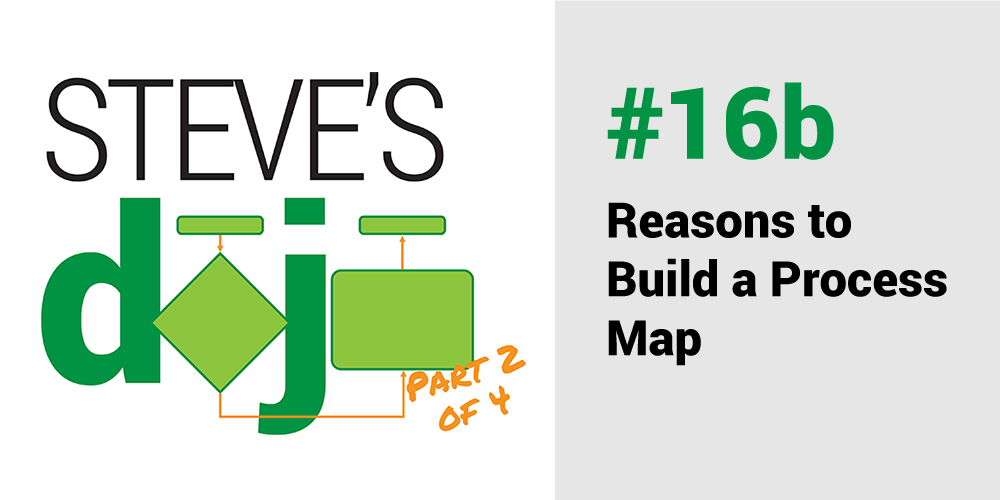Process Maps 101
What’s a process map?
A process’s steps/events in a graphic display.
Why use a process map?
Understand how the process actually works.
Can I see an example?
UNI Clinical Assessment Center referral process map
5 Reasons to process map
very time I’m asked to join a team that’s been working on a big problem I ask three questions upon arriving:
- How do you measure the success of this process?
- Have you mapped the current state process?
- Where are the donuts?
I ask question 2 because just seeing the process on the page helps make the problem seem easier. Just one of many good reasons to process map.
A process map isn’t a magic elixir; we could certainly brainstorm a handful of value improvement situations for which a process map would be overkill. However, given their low cost and relative simplicity, they are very likely a good use of your time.
Here are my top 5 reasons to take the time to build a process map.
1. To share your understanding of the process
I’ve seen it happen over and over again: Experts from different parts of a process discover upstream or downstream nuances of which they were unaware or didn’t fully understand, leading them to make more fully informed decisions about improvement. When teams decide they don’t need a process map because they came to the effort fully informed, chances are good they already have a solution in mind and will shortchange much of the methodology. When they go through process mapping together, it enables them to develop insights about their work and identify process improvement opportunities together.
2. Involve the experts who do the work
Process mapping in a vacuum largely misses the point. Much of the value comes from discussing the process in a facilitated session with the hands-on personnel. And yeah, facilitation is a skill many of us aren’t comfortable with. If you find yourself in this situation, please feel free to ask Value Engineering for assistance. We’ll be glad to help. We’ll also advise you to consider the two rules, schedule a working session in a large conference room with a big whiteboard (preferably near the gemba in question), and invite the experts who do the work. When it’s the bosses doing the process mapping, chances are you’ll end up with the sposda state.
3. It’s low-tech
Process Mapping Series
This makes it accessible to all. Start with Post-its on a whiteboard and move to PowerPoint. Visio is powerful and easy to use. Its downfall is that most people aren’t familiar with it and don’t have it installed on their computers (despite it being freely available for University of Utah employees). So if you send your team a Visio file they may not be able to edit it. Then you’ll send it as a PDF and they still won’t be able to edit it. They’ll print it, mark it up with pen, scan it, and email it back to you and you’ll edit it. This is wasteful, specifically, it’s over-processing.
4. Build skills
You increase your value to the enterprise with this skill. But if you want to gain the skill, you need practice. Practice, of course, requires patience (another way of saying you need to allow yourself a few iterations). You won’t break anything. It’ll only cost a little paper and a few electrons. We can spare the cost if you can spare the time.
5. You will use it later
Process maps can serve many purposes including accelerating communications. That is, process maps offer you ROI later in the project and often are used as reference documents long after the project has closed. If those two enticements aren’t enough to convince you to make the time investment, consider why you think mapping a process will take too much time.
- Is it because the process is so simple it’s not worth any time? See the first point in this list.
- Is it that you’re unsure how to proceed? See point 2, 3 or 4.
- Is it because the process is so complex? In this case, consider reducing the level of detail. A team could start with a SIPOC or a value stream map (both low detail process maps) or you could limit the team to a maximum of 20 boxes in the first round and then ask the team which of the 20 needs more detail.
- Is it because you’re not sure how it would help move your project forward? In this case, revisit Rule 2 from last time: Have a purpose. (And perhaps consult with a value engineer.)
- Is it not just process mapping, but you’ve no time for any improvement work? This is a much bigger issue. Call Value Engineering. Perhaps we can help.
Next time: Common facilitation challenges when process mapping.
Steve Johnson
To celebrate the New Year, Value Engineer Mitch Cannon applied statistics to weight loss. He was quickly reminded of an important lesson that applies in health care: when you’re trying to improve, don’t overreact to data.
Balancing uncertainty, fear, and emotions isn’t easy — especially in health care. Family practice physician Kyle Bradford Jones looks outside of his practice to identify two common biases that affect how we behave in the face of perceived risk. His key insight? The risk that isn’t directly in front of us may be mistaken for no risk at all.
It’s the third consecutive post in the Dojo’s summer of process mapping. Today I discuss 4 common facilitation issues LSS practitioners can avoid prior to, and during a mapping effort.
